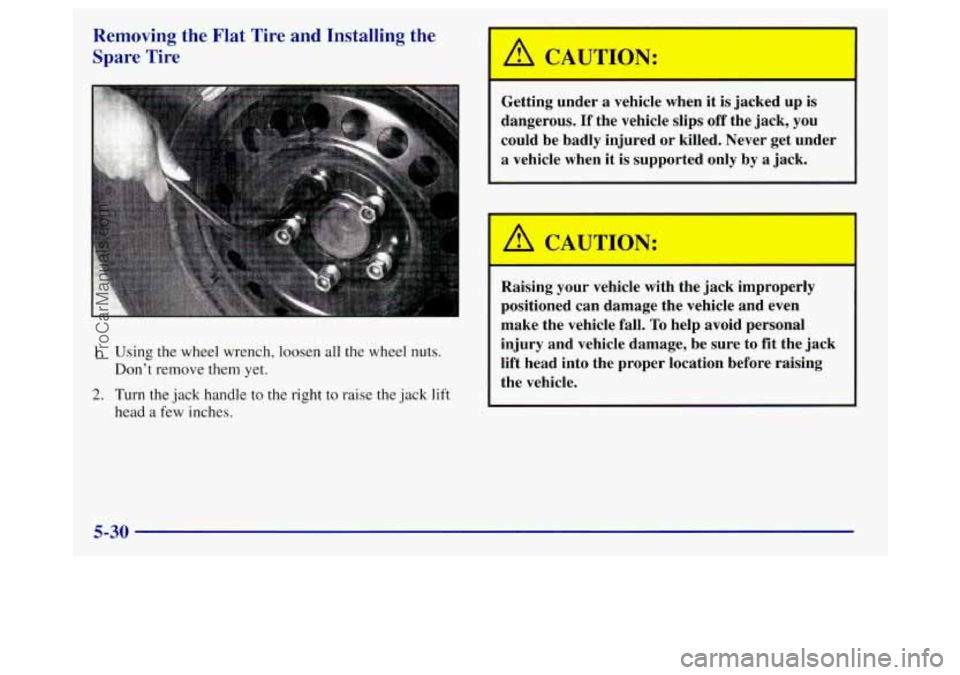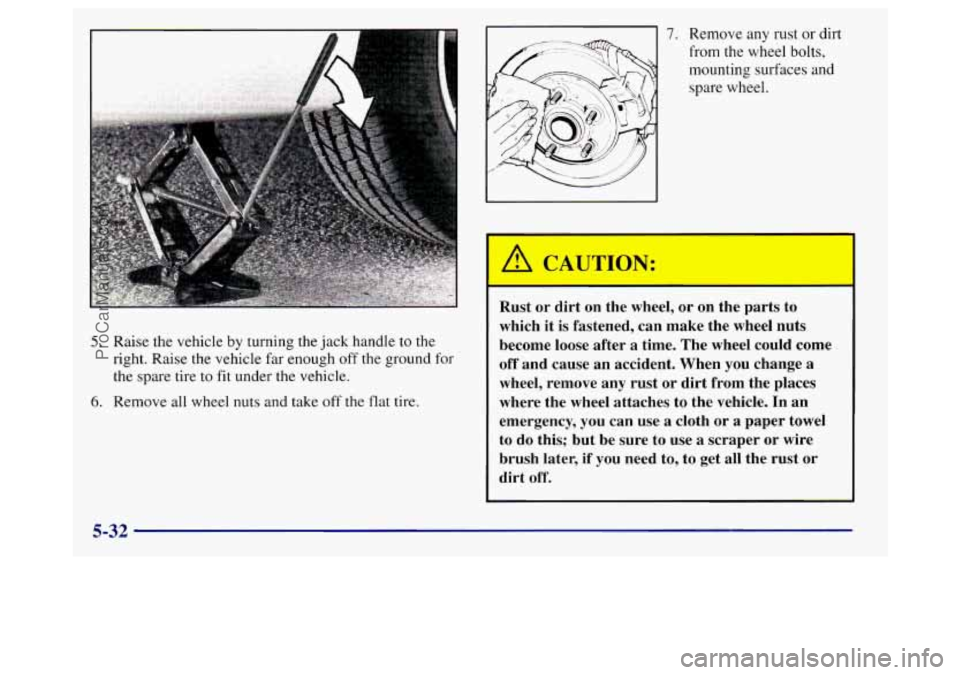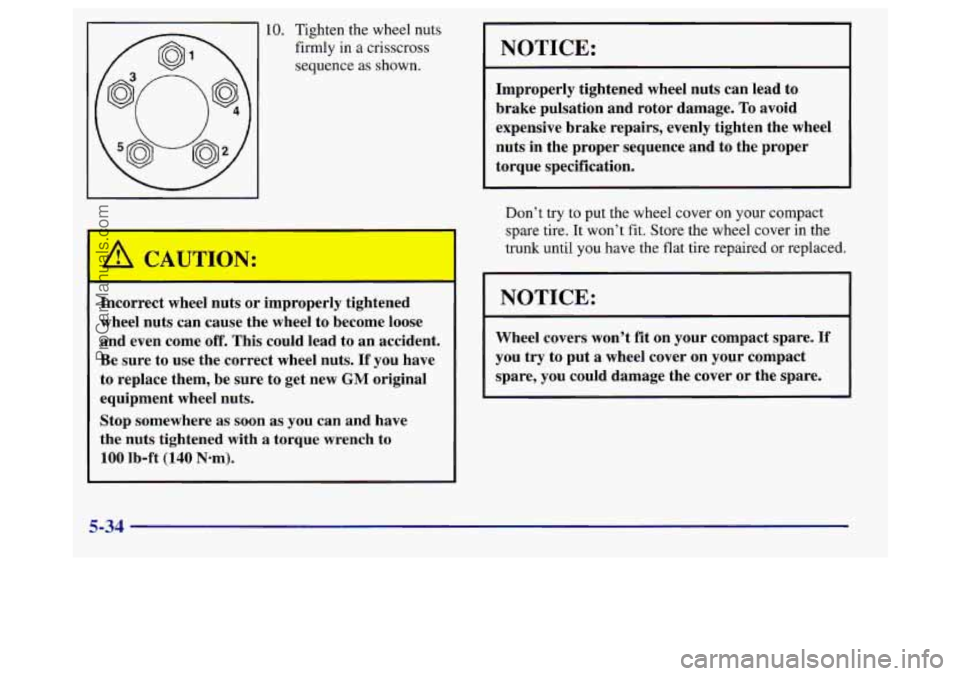spare tire BUICK REGAL 1998 Owners Manual
[x] Cancel search | Manufacturer: BUICK, Model Year: 1998, Model line: REGAL, Model: BUICK REGAL 1998Pages: 388, PDF Size: 20.19 MB
Page 227 of 388

Section 5 Problems on the Road
Here you’ll find what to do about some problems that can occur on the road.
5-2
5-3
5-8
5-15
5- 17 Hazard Warning
Flashers
Jump Starting
Towing Your Vehicle
Engine Overheating
Cooling System 5-25
If a Tire Goes Flat
5-26 Changing a Flat
Tire
5-37 Compact Spare Tire
5-38
If You’re Stuck: In Sand, Mud,
Ice or Snow
5-1
ProCarManuals.com
Page 253 of 388

Removing the Spare Tire and Tools
(See “Compact Spare Tire” later in this section for more
information about the compact spare.)
1. Pull the carpeted mat up from the floor of the trunk
and turn the center nut
on the compact spare cover to
the left to remove it. Then lift and remove the cover.
2. Remove the spare tire.
5-27
ProCarManuals.com
Page 256 of 388

Removing the Flat Tire and Installing the
Spare Tire
Getting under a vehicle when it is jacked up is
dangerous. If the vehicle slips
off the jack, you
could be badly injured or killed. Never get under
a vehicle when it is supported only by a jack.
1. Using the wheel wrench, loosen all the wheel nuts.
2. Turn the jack handle to the right to raise the jack lift
Don’t remove them yet.
head
a few inches.
I A CAUTION:
Raising your vehicle with the jack improperly
positioned can damage the vehicle and even
make the vehicle fall.
To help avoid personal
injury and vehicle damage, be sure to
fit the jack
lift head into the proper location before raising
the vehicle.
5-30
ProCarManuals.com
Page 257 of 388

FRONT VEHICLE
\ \
- REAR EDGE OF FRONT
WHEEL OPENING
3. For jacking at the vehicle’s front location, put the
jack lift head about
6 inches (1 5 cm) from the rear
edge of the front wheel opening or just behind the
two bolts as shown.
FRONT EDGE OF
REAR WHEEL
OPENING
4. For jacking at the vehicle’s rear location, put the jack
lift head about
5 inches (13 em) from the front edge
of the rear wheel opening or just behind the off-set
as shown.
Put the compact spare tire near
you.
5-31
ProCarManuals.com
Page 258 of 388

5. Raise the vehicle by turning the jack handle to the
right. Raise the vehicle far enough off the ground for
the spare tire to fit under the vehicle.
6. Remove all wheel nuts and take off the flat tire.
7. Remove any rust or dirt
from the wheel bolts,
mounting surfaces and
spare wheel.
A CAUTION:
Rust or dirt on the wheel, or on the parts to
which it is fastened, can make the wheel nuts
become loose after a time. The wheel could come
off and cause an accident. When you change a
wheel, remove any rust or dirt from the places
where the wheel attaches to the vehicle. In an
emergency, you can use a cloth or
a paper towel
to do this; but be sure to use a scraper or wire
brush later, if you need to, to get all the rust or
dirt off.
5-32
ProCarManuals.com
Page 260 of 388

10. Tighten the wheel nuts
firmly in a crisscross
sequence as shown.
/!1 CA’, TION:
Incorrect wheel nuts or improperly tightened
wheel nuts can cause the wheel to become loose
and even come
off. This could lead to an accident.
Be sure to use the correct wheel nuts.
If you have
to replace them, be sure to get new
GM original
equipment wheel nuts.
Stop somewhere as soon as you can and have
the nuts tightened with
a torque wrench to
100 Ib-ft (140 Nom).
NOTICE:
Improperly tightened wheel nuts can lead to
brake pulsation and rotor damage. To avoid
expensive brake repairs, evenly tighten the wheel
nuts in the proper sequence and to the proper
torque specification.
Don’t try to put the wheel cover
on your compact
spare tire. It won’t fit. Store the wheel cover in the
trunk until you have the flat tire repaired
or replaced.
NOTICE:
Wheel covers won’t fit on your compact spare. If
you try to put a wheel cover on your compact
spare, you could damage the cover or the spare.
5-34
ProCarManuals.com
Page 261 of 388

Storing the Flat Tire and Tools
Storing a jack, a tire or other equipment in the
passenger compartment
of the vehicle could
cause injury.
In a sudden stop or collision, loose
equipment could strike someone. Store
all these
in the proper place.
After you’ve put the compact spare tire on your vehicle,
you’ll need to store the flat tire in your trunk. Use the
following procedure to secure the flat tire
in the trunk.
When storing a full-size tire you must use the extension
with the protector/guide to help avoid wheel surface
damage. Use the extension and protector/guide located
in the foam holder.
To store a full-size tire, place the tire
valve stem facing down and then remove
the
protector/guide and attach the retainer securely. When reinstalling
a compact spare tire, put the
protector/guide back in the foam holder. Store the cover
as far forward as possible.
5-35
...
ProCarManuals.com
Page 262 of 388

Storing the Spare Tire and Tools
Storing a jack, a tire or other equipment in the
passenger compartment
of the vehicle could
cause injury. In a sudden stop or collision, loose
equipment could strike someone. Store all these
in the proper place.
The compact spare is for temporary use only. Replace
the compact spare tire with a full-size tire
as soon as you
can. See “Compact Spare Tire” in the Index. See the
storage instructions label to replace your compact spare
into your trunk properly.
Be sure
to calibrate your low tire pressure system after
you replace your compact spare tire with a full-sized
one. See “Tire Pressure Monitor”
in the Index.
1. Retainer
2. Cover
3. Retainer (full-size tire)
4. Compact Spare Tire
5. Nut
6. Jack
7. Wrench
8. Lock Nut Tool
9. Foam Holder
10. Bolt Screw
11. Extension and
Protector/Guide
5-36
ProCarManuals.com
Page 263 of 388

Compact Spare Tire
Although the compact spare tire was fully inflated when
your vehicle was new, it can lose air after a time.
Check the inflation pressure remhrly. It should be
60 psi (420 Wa).
After installing the compact spare on your vehicle, you
should stop as soon as possible and make sure your
spare tire is correctly inflated. The compact spare is
made to perform well at speeds up to
65 mph
(105 kmk) for distances up to 3,000 miles (5 000 km),
so you can finish your trip and have your full-size tire
repaired or replaced where you want. You must calibrate
the tire pressure monitor system after installing or
removing the compact spare. See “Tire Pressure
Monitor”
in the Index. The system may not work
correctly when the compact spare
is installed on the
vehicle. Of course, it’s best to replace your spare with a
full-size tire as soon as you can.
Your spare will last
longer and be in good shape in case you need it again.
NOTICE:
When the compact spare is installed, don’t take
your vehicle through an automatic car wash with
guide rails. The compact spare can get caught on
the rails. That can damage the tire and wheel,
and maybe other parts
of your vehicle.
Don’t use your compact spare on other vehicles.
And don’t
mix your compact spare tire or wheel with
other wheels or tires. They won’t fit. Keep your spare
tire and its wheel together.
NOTICE:
Tire chains won’t fit your compact spare. Using
them can damage your vehicle and can damage
the chains too. Don’t use tire chains on your
compact spare.
5-37
ProCarManuals.com
Page 307 of 388

Inflation -- Tire Pressure
The Tire-Loading Information label, which is on the
inside
of the trunk lid, shows the correct inflation
pressures for your tires when they’re cold. “Cold”
means your vehicle has been sitting for at least three
hours or driven no more than
1 mile (1.6 km).
NOTICE:
Don’t let anyone tell you that underinflation or
overinflation is
all right. It’s not. If your tires
don’t have enough air (underinflation), you can
get the following:
Too much flexing
Too much heat
Tire overloading
Bad wear
Bad handling
Bad fuel economy.
NOTICE: (Continued) NOTICE:
(Continued)
If your tires have too much air (overinflation),
you can get the following:
Unusual wear
Bad handling
Rough ride
Needless damage from road hazards.
When to Check
Check your tires once a month or more.
Don’t forget your compact spare tire. It should be at
60 psi (420 kPa).
How to Check
Use a good quality pocket-type gage to check tire
pressure. You can’t tell
if your tires are properly inflated
simply by looking at them. Radial tires may look
properly inflated even when they’re underinflated.
Be sure to put the valve caps back on the valve
stems. They help prevent leaks by keeping out
dirt
and moisture.
6-43
ProCarManuals.com